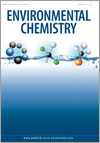EN11016Humic Ion-Binding Model VII: a revised parameterisation of cation-binding by humic substances
Natural organic matter exerts a powerful control on chemical conditions in waters and soils, affecting pH and influencing the biological availability, transport and retention of metals. To quantify the reactions, we collated a wealth of laboratory data covering 40 metals and acid–base reactions, and used them to parameterise the latest in a series of Humic Ion-Binding Models. Model VII is now available to interpret field data, and contribute to the prediction of environmental chemistry.




